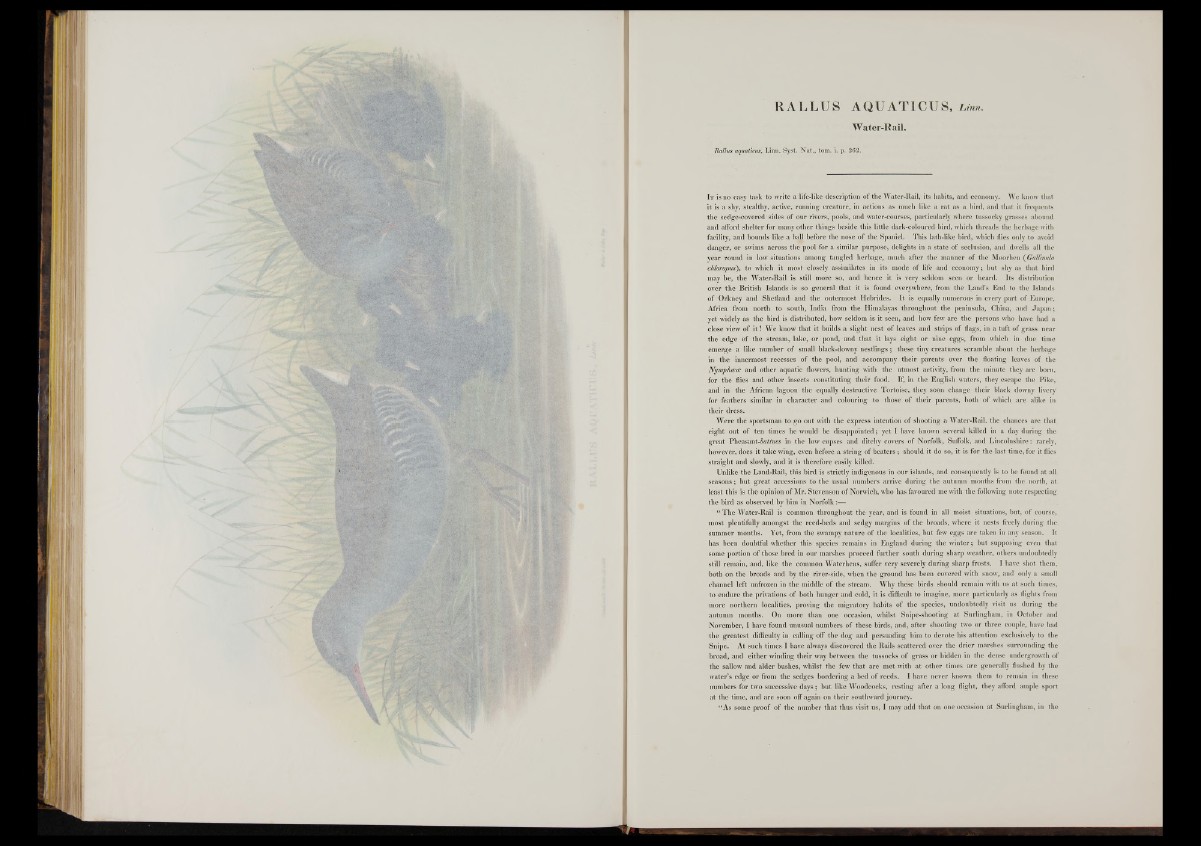
RALLUS AQUATICUS, Linn.
Water-Rail.
liallus aquaticus, Linn. Syst. Nat., tom. i. p. 262.
It is no easy task to write a life-like description of the Water-Rail, its habits, and economy. We know that
it is a shy, stealthy, active, running creature, in actions as mucli like a rat as a bird, and that it frequents
the sedge-covered sides of our rivers, pools, and water-courses, particularly where tussocky grasses abound
and afford shelter for many other things beside this little dark-coloured bird, which threads the herbage with
facility, and bounds like a ball before the nose of the Spaniel. This lath-like bird, which flies only to avoid
danger, or swims across the pool for a similar purpose, delights in a state of seclusion, and dwells all the
year round in low situations among tangled herbage, much after the manner of the Moorhen ( Gallinula
chloropus), to which it most closely assimilates in its mode of life and economy; but shy as that bird
may be, the Water-Rail is still more so, and hence it is very seldom seen or heard. Its distribution
over the British Islands.is so general that it is found everywhere, from the Land’s End to the Islands
o f Orkney and Shetland and the outermost Hebrides. It is equally numerous in every part of Europe,
Africa from north to south, India from the Himalayas throughout the peninsula, China, and J a p a n ;
yet widely as the bird is distributed, how seldom is it seen, and how few are the persons who have had a
close view o f i t ! We know that it builds a slight nest of leaves and strips of flagsj in a tuft of grass near
the edge o f the stream, lake, or pond, and that it lays eight or nine eggs, from which in due time
emerge a like number o f small black-downy nestlings; these tiny creatures scramble about the herbage
in the innermost recesses of the pool, and accompany their parents over the floating leaves of the
Nymphtsce and other aquatic flowers, hunting with the utmost activity, from the minute they are born,
for the flies and other insects constituting their food. If, in the English waters, they escape the Pike,
and in the African lagoon the equally destructive Tortoise, they soon change their black downy livery
for feathers similar in character and colouring to those of their parents, both of which are alike in
their dress.
Were the sportsman to go out with the express intention o f shooting a Water-Rail, the chances are that,
eight out o f ten times he would b.e disappointed; yet I have known several killed in a day during the
great Pheasant-foi/wes in the low copses and ditchy covers of Norfolk, Suffolk, and Lincolnshire: rarely,
however, does it take wing, even before a string o f b eaters; should it do so, it is for the last time, for it flies
straight and slowly, and it is therefore easily killed.
Unlike the Land-Rail, this bird is strictly indigenous in our islands, and consequently is to be found a t all
seasons; but great accessions to the usual numbers arrive during the autumn months from the north, at
least this is the opinion o f M r. Stevenson o f Norwich, who has favoured me with the following note respecting
the bird as observed by him in Norfolk:—
“ The Water-Rail is common throughout the year, and is found in all moist situations, but, o f course,
most plentifully amongst the reed-heds and sedgy margins o f the broads, where it nests freely during the.
summer months. Yet, from the swampy nature of the localities, but few eggs are taken in any season. It
has been doubtful whether this species remains in England during the w in ter; but supposing even that
some portion of those bred in our marshes proceed further south during sharp weather, others undoubtedly
still remain, and, like the common Waterhens, suffer very severely during sharp frosts. I have shot them,
both on the broads and by the river-side, when the ground has been covered with snow, and only a small
channel left unfrozen in the middle of the stream. Why these birds should remain with us a t such times,
to endure the privations of both hunger and cold, it is difficult to imagine, more particularly as flights from
more northern localities, proving the migratory habits of the species, undoubtedly visit us during the
autumn months. On more than one occasion, whilst Snipe-shooting a t Surlingham, in October and
November, I have found unusual numbers o f these birds, and, after shooting two or three couple, have had
the greatest difficulty in calling- off the dog and persuading him to devote his attention exclusively to the
Snipe. At such times I have always discovered the Rails scattered over the drier marshes surrounding the
broad, and either winding their way between the tussocks o f grass or hidden in the dense undergrowth of
the sallow and alder bushes, whilst the few that are met with a t other times are generally flushed by the
water’s edge o r from the sedges bordering a bed o f reeds. I have never known them to remain in these
numbers for two successive days; but like Woodcocks, resting after a long flight, they afford ample sport
at the time, and are soon off again on their southward journey.
“ As some proof of the number that thus visit us, I may add that on one occasion at Surlingham, in the